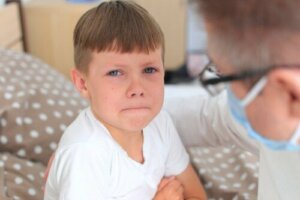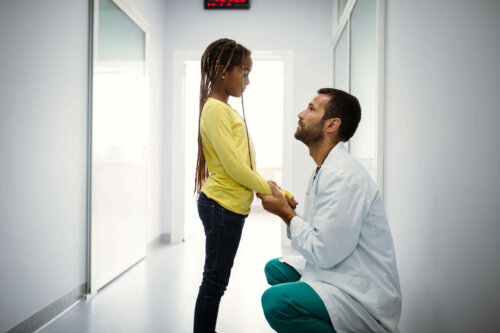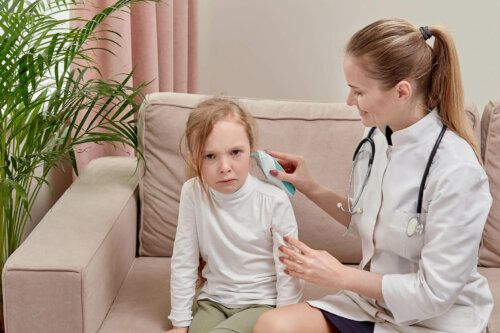4 Tips to Help Your Child Lose Their Fear of the Doctor

One of the most common fears in childhood is the fear of the doctor, especially between the ages of 2 and 5. Is this the case with your child? If so, the following article will interest you because we’ll reveal some tips that will help your little one overcome this fear.
But first, it must be clarified that it’s normal for children to feel uncertainty and insecurity when having to go to the doctor. They have to face an unknown situation in which a person outside of their immediate environment invades their personal space, and on some occasions, performs procedures that cause some pain or discomfort.
4 tips to help your child lose their fear of the doctor

1. Notify doctor visits in advance
If your child perceives a doctor’s visit as something threatening and dangerous, it’s important that they know they have a medical appointment several days in advance. This will help in the sense that the child won’t be taken by surprise and can acclimate to the idea little by little.
2. Transmit security and trust
As a mother or father, in this situation, you have to act as a source of support and trust. To do this, it’s convenient that you explain to your child that you’ll be with them at all times during the doctor’s visit and that they shouldn’t worry because you’ll be there for whatever they need.
Additionally, to make the child feel more secure, you can tell them to choose one of their favorite toys or objects (a stuffed animal, a doll, a blanket, etc.) to accompany them during the consultation.
3. Play doctor with them and tell them stories set in health centers
A great idea to make your child less afraid of the doctor is to play games related to the health field with them. In a playful way, the child is given the opportunity to experience the roles of a doctor or nurse and patient. They also learn what procedures they’ll go through.
Another good idea is to get hold of a story set in a doctor’s office or hospital and read it together. This way, they’ll learn all about the environment that the doctor works in, which will lessen their uncertainty.
4. Avoid any negative comments about the work of healthcare personnel
Sometimes, adults complain and criticize the work of healthcare personnel or share their bad experiences with doctors. If you have a child that’s afraid to go to the doctor, you should avoid making any type of negative comments in front of them because you’ll only be feeding their fears.
As a parent, one has to convey that doctors are there to help people and not harm them. It has to be clear that going to the doctor isn’t about punishment, but rather a need to be healthy and to fully enjoy life.
Fear or phobia of the doctor?
If you think your child’s fear of going to the doctor is irrational or excessive, then it may not be a simple childhood fear but rather a phobia. Specifically, your child may suffer from iatrophobia.

In this case, surely, the aforementioned advice won’t serve to reduce or end the problem. It’s recommended to seek help from a psychologist that’s specialized in the treatment of phobias.
What is iatrophobia?
Iatrophobia is a type of social phobia whose main characteristic consists of experiencing an extreme and irrational fear of doctors or health personnel in general. People who suffer from this disorder, in these situations, feel intense discomfort, anxiety and even true panic.
The importance of treating the fear of the doctor
Ultimately, it’s important to treat the fear of the doctor as soon as the problem is detected. At the end of the day, it’s inevitable to go to them both in childhood and throughout life.
As soon as your child understands that this person in a white coat is their ally and not their enemy, they’ll be able to face visits to the doctor in a more relaxed and less insecure way.
One of the most common fears in childhood is the fear of the doctor, especially between the ages of 2 and 5. Is this the case with your child? If so, the following article will interest you because we’ll reveal some tips that will help your little one overcome this fear.
But first, it must be clarified that it’s normal for children to feel uncertainty and insecurity when having to go to the doctor. They have to face an unknown situation in which a person outside of their immediate environment invades their personal space, and on some occasions, performs procedures that cause some pain or discomfort.
4 tips to help your child lose their fear of the doctor

1. Notify doctor visits in advance
If your child perceives a doctor’s visit as something threatening and dangerous, it’s important that they know they have a medical appointment several days in advance. This will help in the sense that the child won’t be taken by surprise and can acclimate to the idea little by little.
2. Transmit security and trust
As a mother or father, in this situation, you have to act as a source of support and trust. To do this, it’s convenient that you explain to your child that you’ll be with them at all times during the doctor’s visit and that they shouldn’t worry because you’ll be there for whatever they need.
Additionally, to make the child feel more secure, you can tell them to choose one of their favorite toys or objects (a stuffed animal, a doll, a blanket, etc.) to accompany them during the consultation.
3. Play doctor with them and tell them stories set in health centers
A great idea to make your child less afraid of the doctor is to play games related to the health field with them. In a playful way, the child is given the opportunity to experience the roles of a doctor or nurse and patient. They also learn what procedures they’ll go through.
Another good idea is to get hold of a story set in a doctor’s office or hospital and read it together. This way, they’ll learn all about the environment that the doctor works in, which will lessen their uncertainty.
4. Avoid any negative comments about the work of healthcare personnel
Sometimes, adults complain and criticize the work of healthcare personnel or share their bad experiences with doctors. If you have a child that’s afraid to go to the doctor, you should avoid making any type of negative comments in front of them because you’ll only be feeding their fears.
As a parent, one has to convey that doctors are there to help people and not harm them. It has to be clear that going to the doctor isn’t about punishment, but rather a need to be healthy and to fully enjoy life.
Fear or phobia of the doctor?
If you think your child’s fear of going to the doctor is irrational or excessive, then it may not be a simple childhood fear but rather a phobia. Specifically, your child may suffer from iatrophobia.

In this case, surely, the aforementioned advice won’t serve to reduce or end the problem. It’s recommended to seek help from a psychologist that’s specialized in the treatment of phobias.
What is iatrophobia?
Iatrophobia is a type of social phobia whose main characteristic consists of experiencing an extreme and irrational fear of doctors or health personnel in general. People who suffer from this disorder, in these situations, feel intense discomfort, anxiety and even true panic.
The importance of treating the fear of the doctor
Ultimately, it’s important to treat the fear of the doctor as soon as the problem is detected. At the end of the day, it’s inevitable to go to them both in childhood and throughout life.
As soon as your child understands that this person in a white coat is their ally and not their enemy, they’ll be able to face visits to the doctor in a more relaxed and less insecure way.
All cited sources were thoroughly reviewed by our team to ensure their quality, reliability, currency, and validity. The bibliography of this article was considered reliable and of academic or scientific accuracy.
- Pérez-Grande, M. D. (2000). El miedo y sus trastornos en la infancia. Prevención e intervención educativa. Aula, 12.
This text is provided for informational purposes only and does not replace consultation with a professional. If in doubt, consult your specialist.








